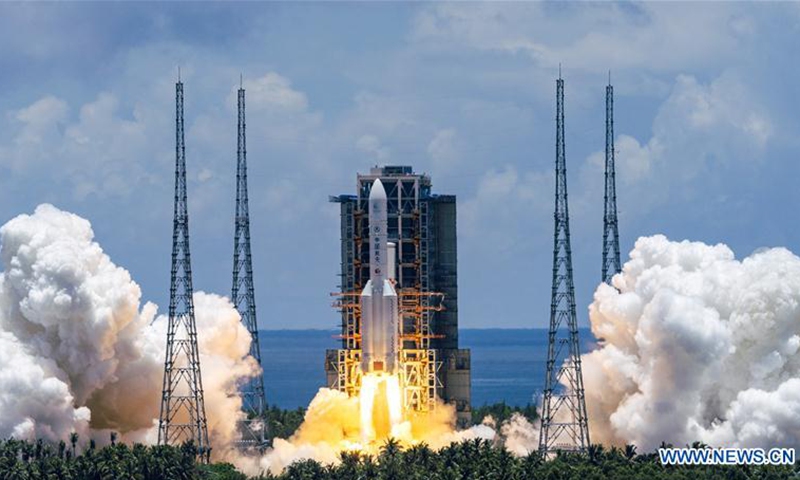
A Mars probe is launched on a Long March-5 rocket from the Wenchang Spacecraft Launch Site in south China's Hainan Province, July 23, 2020.(Photo: Xinhua)
East China's Zhejiang Province plans to build an international spacecraft launch center in five years with total investment of 20 billion yuan ($3 billion) that will carry out 100 missions per year.
However, industry experts on Wednesday called for prudence in approving the project, citing difficulties in hiring experienced launch teams, and uncertain outlook of future launch market.
According to a draft proposal for Zhejiang's key infrastructure projects for the 14th Five-Year Plan period (2021-25) posted on the provincial government website, the province will construct a space launch center in Xiangshan county, Ningbo. The facility will cover 67 square kilometers, including a launch site of 35 square kilometers and support facilities of 32 square kilometers.
Moreover, a document on the Administrative Committee of the Ningbo Free Trade Zone website showed that a company has already won the bid to build a commercial satellite assembly and testing facility that covers 4,500 square meters, with a launch pad area of about 3,000 square meters.
Ningbo lies at a favorable latitude for space launches and has a vast coastline, but given the changes and uncertainties in the launch market, the local government should be prudent in approving the plan for the sake of local economic development and public benefits, Wang Yanan, chief editor of Beijing-based Aerospace Knowledge magazine, told the Global Times.
Located in the southern wing of the developed Yangtze River Delta region, the coastal city of Ningbo is known around the world for its superiority in port throughput capacity. The city's GDP in 2020 reached 1.24 trillion yuan.
Huang Zhicheng, a space industry expert, told the Global Times on Wednesday that the relatively low threshold for building spacecraft launch sites is attracting more provinces, noting that Northwest China's Shaanxi Province also plans to build such a site.
In addition, Chinese rocket manufacturer China Rocket Co and the municipal government of Haiyang in East China's Shandong Province reached a deal in December 2020 to build a 163-hectare production base for solid-propellant rockets, which will offer services such as seaborne rocket launches.
Wang said that maritime platform's advantages of flexibility and safety may mean that, eventually, there will be no need for more land launch facilities, along with the advance of technologies.
There are four satellite launch centers in China: Jiuquan Satellite Launch Center in Northwest China's Gansu Province, Taiyuan Satellite Launch Center in North China's Shanxi Province, Xichang Satellite Launch Center in Southwest China's Sichuan Province, and Wenchang Spacecraft Launch Site in South China's Hainan Province.
"It's estimated that China will need to launch more than 1,000 low-Earth orbit satellites in the upcoming years, but a carrier rocket like the Long March-5 can handle 60 satellites at a time. Hence, existing spacecraft launch sites can fully meet market needs," Huang said, noting that it's easier to add launch pads than build entirely new sites and train professional crew.
He said that commercial aerospace companies should focus on developing new technologies in rockets, spacecraft and low-Earth orbit satellites, in order to compete with developed countries like the US.




